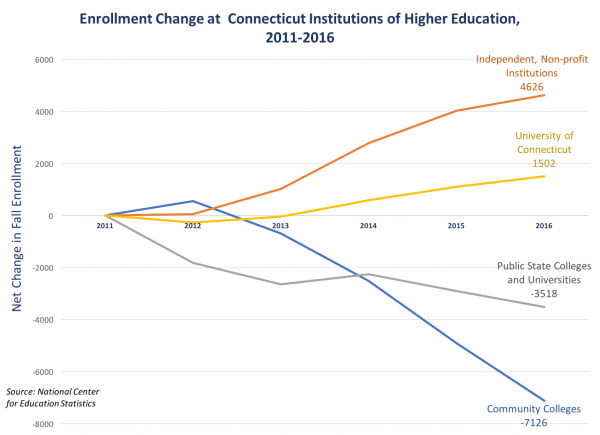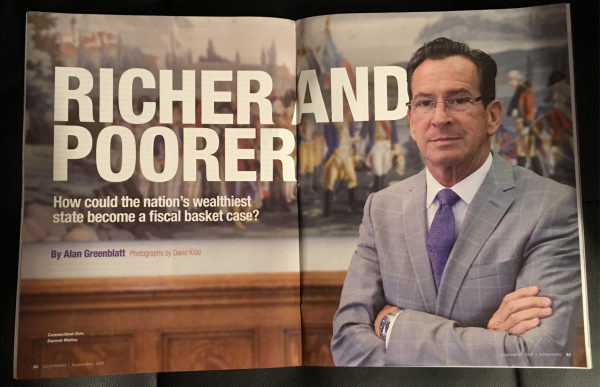More Changes Proposed as Enrollment Drops at State Colleges, Universities; Feedback Sought on Consolidation Plan
/The recent decision by the Board of Regents of the Connecticut State Colleges & Universities (CSCU) to begin offering students from New York and New Jersey the considerably lower in-state tuition rates in an effort to stem an increasing drop in enrollment at Western Connecticut State University may be the tip of the iceberg.
Since 2011, enrollment numbers at higher education institutions in Connecticut have been moving in very different directions, according to data developed by the Connecticut Conference of Independent Colleges (CCIC) from the National Center for Education Statistics.
The data show that the state’s community college system has experienced a net loss of 7,126 students, and the state’s four regional universities – Western, Central, Southern and Eastern Connecticut – saw a net loss of 3,518 students between 2011 and 2016.
Trending in the opposite direction has been the University of Connecticut, with a net increase of 1,502 students, and the independent, non-profit institutions, was an increase of 4,626 students.
CCIC member institutions include Albertus Magnus College, Connecticut College, Fairfield University, Goodwin College, Mitchell College, Quinnipiac University, Rensselaer at Hartford, Sacred Heart University, St. Vincent's College, Trinity College, University of Bridgeport, University of Hartford, University of New Haven, University of Saint Joseph, Wesleyan University and Yale University.
Currently, in-state students pay $10,418 in annual tuition at Western, while out-of-state students pay $23,107. Published reports indicate that enrollment at the university has dropped by more than 700 students over the past six years. The university serves about 5,700 students, with more than 90 percent of them coming from Connecticut.
Similar initiatives at the other three colleges are less likely, as they are located in Willimantic, new Haven and New Britain, not adjacent to any state line. Central Connecticut State University is the largest of four universities within the CSCU system, serving nearly 11,800 students--9,800 undergraduates, and 2,000 graduate students.
Last year, in a program that was promoted with radio advertising, the CSCU board approved a plan that permitted Asnuntuck Community College in Enfield to admit students from Massachusetts to enroll at in-state rates. And last spring, the board allowed six other community colleges located near state borders to do the same starting this fall. The plan boosted enrollment at Asnuntuck; data on the other colleges is not yet available. 
Earlier this year, the CSCU system proposed merging the 12 community colleges into one college with 12 branch campuses, as a cost-saving measure, and, officials say, to direct more resources to students. That plan is pending. If approved, the change would make the newly named Connecticut Community College the fifth largest in the country with more than 52,000 students, reports indicate. Officials indicate that "Only a few of these recommendations will require policy changes by the Board of Regents. The majority of the administrative recommendations can be implemented as soon as time and resources are available to complete."
Currently, the system is soliciting feedback on the proposal with an on-line poll on the CSCU website. The survey asks respondents to offer opinions on the plans, as well as suggestions and opinions on strengths of the 12 into 1 plan. The survey is open until Nov. 20.






 In Connecticut, individuals earning more than $200,000 gave 66.4 percent of all Connecticut giving, down 1.7 percent from 2012, according to the Chronicle analysis. The portion of all givers in this income bracket in Connecticut down 0.2 percent while the giving per itemizer is down 20.6 percent. In looking at the state’s major metropolitan areas, greater Bridgeport, Hartford, and New Haven, the analysis round that giving rates for taxpayers at four income levels fell below the average for the size group in each of the metropolitan areas.
In Connecticut, individuals earning more than $200,000 gave 66.4 percent of all Connecticut giving, down 1.7 percent from 2012, according to the Chronicle analysis. The portion of all givers in this income bracket in Connecticut down 0.2 percent while the giving per itemizer is down 20.6 percent. In looking at the state’s major metropolitan areas, greater Bridgeport, Hartford, and New Haven, the analysis round that giving rates for taxpayers at four income levels fell below the average for the size group in each of the metropolitan areas.

 The U.S. Census Bureau’s
The U.S. Census Bureau’s  ensus officials are necessary to obtain more accurate population and demographic counts. If those visits are reduced in order to cut costs, the accuracy of the census itself is likely to diminish, observers say. Connecticut, which does not have independent counts of its entire population, depends heavily on data derived from the U.S. Census for a host of policy and funding decisions.
ensus officials are necessary to obtain more accurate population and demographic counts. If those visits are reduced in order to cut costs, the accuracy of the census itself is likely to diminish, observers say. Connecticut, which does not have independent counts of its entire population, depends heavily on data derived from the U.S. Census for a host of policy and funding decisions.
 Lutzger also handles traffic reporting each morning for Kiss 95.7, Country 92.5, The River 105.9, WELI and KC101, and afternoons on The River 105.9. A native New Yorker, she first came to Connecticut to attend the University of Hartford. In addition to traffic reporting, Dufour is co-host for CT Style, a daily lifestyle program on WTNH. She graduated from the University of Connecticut in 2001 with a bachelor’s degree in broadcast journalism, and handled traffic reporting for WFSB before moving over to WTNH.
Lutzger also handles traffic reporting each morning for Kiss 95.7, Country 92.5, The River 105.9, WELI and KC101, and afternoons on The River 105.9. A native New Yorker, she first came to Connecticut to attend the University of Hartford. In addition to traffic reporting, Dufour is co-host for CT Style, a daily lifestyle program on WTNH. She graduated from the University of Connecticut in 2001 with a bachelor’s degree in broadcast journalism, and handled traffic reporting for WFSB before moving over to WTNH.



 Food and beverage companies often target marketing for nutrient-poor products such as candy, sugary drinks, snack foods, and fast-food restaurants to Hispanic audiences, including youth, the researchers state. They cite previous research that has documented disproportionate exposure to unhealthy food marketing by Hispanic youth in their communities and on TV, but theirs is the first examination of the phenomenon on the internet.
Food and beverage companies often target marketing for nutrient-poor products such as candy, sugary drinks, snack foods, and fast-food restaurants to Hispanic audiences, including youth, the researchers state. They cite previous research that has documented disproportionate exposure to unhealthy food marketing by Hispanic youth in their communities and on TV, but theirs is the first examination of the phenomenon on the internet. g vulnerable populations,” according to the publication’s website, “with the goal of providing optimal outcomes and ultimately health equity for all.” The journal intends to provide coverage ranging from translational research to prevention, diagnosis, treatment, and management of disease and illness, in order to serve as a primary resource for organizations and individuals who serve these populations at the community, state, regional, tribal, and national levels.
g vulnerable populations,” according to the publication’s website, “with the goal of providing optimal outcomes and ultimately health equity for all.” The journal intends to provide coverage ranging from translational research to prevention, diagnosis, treatment, and management of disease and illness, in order to serve as a primary resource for organizations and individuals who serve these populations at the community, state, regional, tribal, and national levels.




 Attracting hundreds of women in manufacturing from across the country, WiM's annual Summit is the only national conference of its kind. This networking and educational event features manufacturing plant tours, professional development tracks, industry roundtables, keynote presentations and social events to expand participants' networks.
Attracting hundreds of women in manufacturing from across the country, WiM's annual Summit is the only national conference of its kind. This networking and educational event features manufacturing plant tours, professional development tracks, industry roundtables, keynote presentations and social events to expand participants' networks. any, TRUMPF Inc., and Pratt & Whitney, all on the opening day of the conference on September 13.
any, TRUMPF Inc., and Pratt & Whitney, all on the opening day of the conference on September 13. Engineers, and George Saiz, President & CEO of The Association for Manufacturing Excellence.
Engineers, and George Saiz, President & CEO of The Association for Manufacturing Excellence. Among the host committee members is the Connecticut Business and Industry Association. The New Haven Manufacturers Association and the Waterbury Regional Chamber’s Manufacturer’s Council are among the Supporting Partners for the Summit.
Among the host committee members is the Connecticut Business and Industry Association. The New Haven Manufacturers Association and the Waterbury Regional Chamber’s Manufacturer’s Council are among the Supporting Partners for the Summit.






























